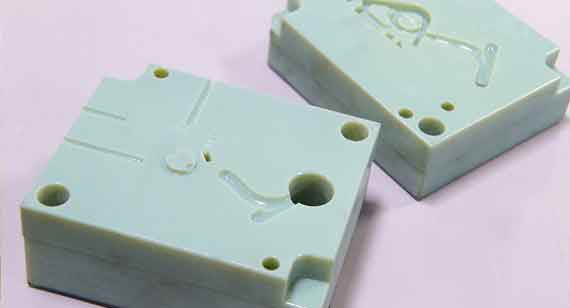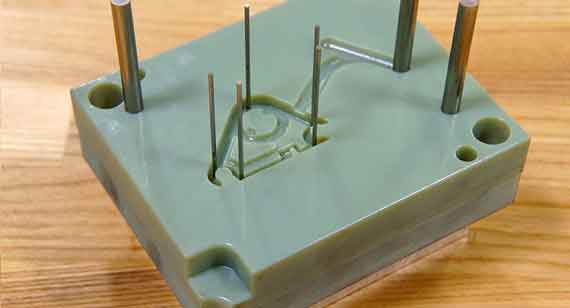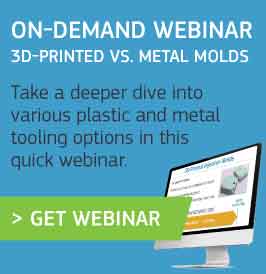3D-Printed Molds vs. Aluminum Tooling

Industrial 3D printing has made a tremendous impact on the manufacturing world. Rapid prototypes are possible within a day, material selection continues to grow stronger and parts with un-manufacturable designs have found their happy place. Recently, some companies have begun using this important technology to produce injection molds.
Molds made with thermoplastics-based 3D printing are kind of like the plastic storage sheds some of us put in our back yards. They’re a little cheaper than metal sheds. They go up quickly and are fine under light loads. Pile too much snow on them, however, and they’ll collapse like a house of cards.
Still, printed molds have their place, and some shops have had good success with them. Proponents argue that 3D printing produces molds up to 90 percent faster and 70 percent cheaper than using traditional moldmaking processes. And while this may be true in some circumstances, it’s important to understand the pros and cons of printed plastic molds compared to those machined from metal.
Quality is King
3D printing builds parts in layers. Because of this, printed parts can exhibit a stair-step effect on any angled surface or wall. Printed molds are no different, and require machining or sanding to remove these small, jagged edges. Holes smaller than 0.039 in. (1mm) must be drilled, larger holes reamed or bored, and threaded features tapped or milled. All of these secondary operations eliminate much of the “print-to-press” speed advantage associated with printed molds.

Size Matters
Part volumes are limited to 10 cubic inches (164 cm3), roughly the size of a grapefruit. And although modern additive machines have impressive accuracy, they cannot compete with the machining centers and EDM equipment at China Metal Parts, which routinely machine mold cavities to +/- 0.003 in. (0.076mm) and part volumes up to approximately 59 cubic inches, about six times larger than parts made with 3D printing.
The Heat Is On
To make material flow properly, injection molding requires very high temperatures. Aluminum and steel molds are routinely subjected to temperatures 500°F (260°C) or greater, especially when processing high-temperature plastics such as PEEK and PEI (Ultem). Aluminum tools can easily produce many thousands of parts, and can also serve as bridge tooling until a production mold is available. Molds produced with stereolithography and similar 3D printing technologies use either photoreactive or thermoset resin, which is cured by ultraviolet or laser light respectively. These plastic molds, though relatively hard, break down fairly quickly when subjected to the demanding thermal cycles of injection molding. In fact, printed molds typically become ineffective within 100 shots of soft, hot plastic such as polyethylene or styrene, and may produce only a handful of parts from glass-filled polycarbonate and other tough thermoplastics.
Comparable Costs
One of the biggest draws of a printed mold is its low cost. Aficionados point to production-grade machined tooling costing $20,000 or more, suggesting this as an apples-to-apples comparison with a $1,000 printed mold. It’s not a fair analogy though, at least not at China Metal Parts. Cost estimates for printed molds are frequently “material only” and do not include labor for assembly and fitting, ejector systems, and miscellaneous hardware. Aluminum molds at China Metal Parts start around $1,500 and are ready to go. Need more parts? With 3D-printed molds, you’ll need to print, machine assemble and test a new mold every 50 to 100 shots. Aluminum tooling has no such constraints, and often see service well past 10,000 shots, regardless of the plastic being used.
Part Design
The principles and practices of conventional injection moldmaking have been in use for more than a century, and are well understood in the industry. Printed molds are fairly new. For example, draft angles must be increased to 5 degrees or more, greatly exceeding that of most aluminum tooling requirements. Ejecting plastic parts from a plastic mold can be challenging, so greater attention must be paid to the placement and quantity of ejector pins. Plastic molds are somewhat flexible, especially at higher molding temperatures, making much thicker cavity walls and lower operating pressures the norm. Gate design is different as well. Tunnel and point gates should be avoided, while sprue, fan and tab gates should be increased to 3 times their normal size. Polymer flow through the printed mold should be oriented in the same direction as 3D print lines, to avoid sticking and improve filling at lower injection pressures. Cooling systems can be used to improve mold longevity somewhat, but will not decrease the substantially longer cycle times seen with printed molds, as plastic tools do not dissipate heat nearly as well as ones made of aluminum or steel.
A Time and a Place
Despite the advantages of rapid injection molding with aluminum tools, there are times when printed molds make sense. For shops that have an idle 3D printing machine, and time available on their injection molding machine to work through the learning curve associated with printing molds, some might argue that equipment should be put to use. Of course, mold designers must understand how to build a functioning tool, or costly rework and rebuilding of molds will be needed. Support people and equipment are needed as well—machinists or toolmakers to sand the mold, fit the pins, bushings, and mounting hardware, and an injection molding machine operator available to dial in the shot size, temperature, and machine pressure, since these will be far different than the parameters he or she is used to with conventional tooling.
However, injection molds produced with 3D printing machines might be a viable alternative if:
- Very low quantities of relatively simple parts with large draft angles are needed.
- Your tool-and-die team is familiar with the design rules of molds made with 3D printing.
- People and machines are available to process and assemble the plastic tool.
For now, it’s probably better to use 3D printing technologies for what they do best: printing parts, not molds.
Upload a CAD model today to see if an aluminum injection mold is right for your next project.
